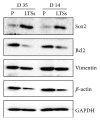Formation of Tumorspheres with Increased Stemness without External Mitogens in a Lung Cancer Model
- PMID: 26880969
- PMCID: PMC4736427
- DOI: 10.1155/2016/5603135
Formation of Tumorspheres with Increased Stemness without External Mitogens in a Lung Cancer Model
Abstract
Like with most solid tumors, the presence of a subpopulation of cancer stem cells (CSCs) or cancer stem-like cells (CS-LCs) has been associated with chemoresistance and tumor relapse in lung cancer cells. In the absence of serum, CSCs/CS-LCs have the ability to grow as lung tumorspheres (LTSs), and this system is routinely used for isolation and characterization of putative CSCs/CS-LCs. Methods to isolate LTSs are usually performed in serum-free media supplemented with specific additives such as epidermal growth factor and basic fibroblast growth factor. In this study, we report the generation of LTSs without the addition of any external mitogenic stimulation. LTSs generated in this manner demonstrated several traits usually associated with increased stemness such as elevated expression of the stemness-associated marker Sox2 and increased chemoresistance to conventional anticancer drugs. In addition, we report that the FDA-approved drug Digitoxin, at concentration close to its therapeutic level, decreased the viability of LTSs and downregulated Sox2 independent of the PI3K/AKT pathway. The potential use of LTSs generated without the addition of any external mitogenic stimulation to study the role of specific factor(s) associated with stemness properties is also discussed.
Figures




Similar articles
-
The Biguanides Metformin and Buformin in Combination with 2-Deoxy-glucose or WZB-117 Inhibit the Viability of Highly Resistant Human Lung Cancer Cells.Stem Cells Int. 2019 Feb 21;2019:6254269. doi: 10.1155/2019/6254269. eCollection 2019. Stem Cells Int. 2019. PMID: 30918522 Free PMC article.
-
Nigericin decreases the viability of multidrug-resistant cancer cells and lung tumorspheres and potentiates the effects of cardiac glycosides.Tumour Biol. 2017 Mar;39(3):1010428317694310. doi: 10.1177/1010428317694310. Tumour Biol. 2017. PMID: 28351327
-
Transcriptional Profiling of Tumorspheres Reveals TRPM4 as a Novel Stemness Regulator in Breast Cancer.Biomedicines. 2021 Oct 1;9(10):1368. doi: 10.3390/biomedicines9101368. Biomedicines. 2021. PMID: 34680485 Free PMC article.
-
Peroxiredoxin II Regulates Cancer Stem Cells and Stemness-Associated Properties of Cancers.Cancers (Basel). 2018 Sep 3;10(9):305. doi: 10.3390/cancers10090305. Cancers (Basel). 2018. PMID: 30177619 Free PMC article. Review.
-
Cancer cells stemness: A doorstep to targeted therapy.Biochim Biophys Acta Mol Basis Dis. 2020 Apr 1;1866(4):165424. doi: 10.1016/j.bbadis.2019.02.019. Epub 2019 Feb 26. Biochim Biophys Acta Mol Basis Dis. 2020. PMID: 30818002 Review.
Cited by
-
Correlating tumor-infiltrating lymphocytes and lung cancer stem cells: a cross-sectional study.Ann Transl Med. 2019 Nov;7(22):619. doi: 10.21037/atm.2019.11.27. Ann Transl Med. 2019. PMID: 31930020 Free PMC article.
-
The Biguanides Metformin and Buformin in Combination with 2-Deoxy-glucose or WZB-117 Inhibit the Viability of Highly Resistant Human Lung Cancer Cells.Stem Cells Int. 2019 Feb 21;2019:6254269. doi: 10.1155/2019/6254269. eCollection 2019. Stem Cells Int. 2019. PMID: 30918522 Free PMC article.
-
Selective and Irreversible Induction of Necroptotic Cell Death in Lung Tumorspheres by Short-Term Exposure to Verapamil in Combination with Sorafenib.Stem Cells Int. 2017;2017:5987015. doi: 10.1155/2017/5987015. Epub 2017 Oct 19. Stem Cells Int. 2017. PMID: 29201061 Free PMC article.
-
Cancer Cell Plasticity: Rapid Reversal of Chemosensitivity and Expression of Stemness Markers in Lung and Breast Cancer Tumorspheres.J Cell Physiol. 2017 Sep;232(9):2280-2286. doi: 10.1002/jcp.25725. Epub 2017 Mar 31. J Cell Physiol. 2017. PMID: 27925198 Free PMC article.
-
Natural Cyclophilin A Inhibitors Suppress the Growth of Cancer Stem Cells in Non-Small Cell Lung Cancer by Disrupting Crosstalk between CypA/CD147 and EGFR.Int J Mol Sci. 2023 May 29;24(11):9437. doi: 10.3390/ijms24119437. Int J Mol Sci. 2023. PMID: 37298389 Free PMC article.
References
Grants and funding
LinkOut - more resources
Full Text Sources
Other Literature Sources

